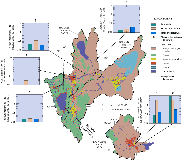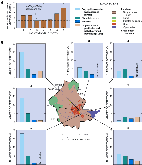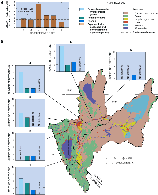Urban activities may create conditions that result in higher-than-normal concentrations of the nutrients, ammonia, nitrite plus nitrate (hereafter referred to as nitrate), and phosphate, trace elements, and synthetic organic compounds including polycyclic aromatic hydrocarbons (PAHs), phthalate esters, phenols, organochlorine pesticides, and polychlorinated biphenyls (PCBs) in water bodies downstream from urban areas. The degree to which downstream water bodies are affected by urban activities depends on many factors such as the size of the urban area, the types of residential, commercial, and industrial activities, and the hydrologic setting.
Between 1974 and 1988, the annual total nitrogen load in Las Vegas Wash downstream from sewage discharge increased more than threefold from 750 to 2,400 tons and closely paralleled the population growth during that time. This nitrogen load consisted almost entirely of ammonia. Except for infrequent rainstorms, streamflow upstream from the sewage discharges (fig. 5) was almost entirely urban drainage (site 1, fig. 7). Downstream from sewage discharges (site 2, fig. 7), streamflow in Las Vegas Wash was mostly sewage effluent (86 percent of streamflow in 1990) [28].

(click for full size image; 52K) Figure 7. Median concentrations of nutrients during 1993-95 were highest downstream from the discharge of tertiary-treated sewage. |
The median ammonia concentration was 2 times higher than the NAWQA
national median downstream from Las Vegas urban area, but nearly 300 times
higher downstream from the discharge of tertiary-treated sewage. Surface-water
samples collected from Las Vegas Wash between April 1993 and April 1995
contained high nutrient concentrations (fig. 7). Ammonia was still a large
proportion of the total nitrogen load downstream from the points of sewage
discharge (fig. 5). All NAWQA samples collected in Las Vegas Wash downstream
from the sewage discharges between April 1993 and April 1995 exceeded the
aquatic-life criterion for un-ionized ammonia (0.07 to 2.1 mg/L as N, depending
on water temperature and pH [29]). Based on data provided by Steven W.
Miller (City of Las Vegas, written commun., 1998), concentrations of ammonia
had decreased fivefold in samples collected from Las Vegas Wash during
1996 and 1997, following full implementation of tertiary treatment. These
greatly reduced concentrations of ammonia indicate that the aquatic-life
criterion for un-ionized ammonia probably is no longer being exceeded.
Nitrate and total-phosphorus concentrations were much higher at the sites on Las Vegas Wash (fig. 7), as compared to sites in the Carson and Truckee River Basins (fig. 7). The median concentration of nitrate for Las Vegas Wash did not exceed the MCL of 10 mg/L as N [7]. |
Truckee River nutrient concentrations were much lower than those in Las Vegas Wash but were greater downstream from the Reno-Sparks urban area and the discharge of tertiary-treated sewage. Between April 1993 and April 1995, ammonia, nitrate, and total phosphorus were much greater (3 to 10 times) in the river at site 5 (fig. 7) downstream from the discharge of tertiary-treated sewage (fig. 5), as compared to sites 3 and 4. However, Steamboat Creek and other tributaries enter the Truckee River between Reno-Sparks (site 4) and site 5. Just upstream from Pyramid Lake (site 6, fig. 7), ammonia and nitrate had decreased to concentrations close to those measured in the forested headwater area (site 3), but total phosphorus remained elevated (fig. 7). A similar pattern of nitrate and dissolved-phosphorus concentrations was documented in the Truckee River from October 1969 to April 1990 [28]. Nine percent of the NAWQA samples at site 5 (fig. 7) exceeded the aquatic-life criterion for un-ionized ammonia. Nitrate concentrations in NAWQA samples from the Truckee River were low compared to other NAWQA Study Units and did not exceed the MCL. Sewage from Reno-Sparks undergoes tertiary treatment prior to discharge. Although concentrations of nutrients in NAWQA samples were low, the State of Nevada has identified elevated levels of total phosphorus, ammonia, and nitrate as special concerns [30].
The sewage effluent had detections of 9 compounds and Las Vegas Wash downstream from the discharge of sewage had detections of 12 compounds, during May-August 1994. Las Vegas Wash transports these pesticides to Las Vegas Bay of Lake Mead.
Fourteen pesticides were detected in surface-water samples from the
Truckee River and its tributaries downstream from Reno-Sparks urban area,
during May-August 1994. Upstream from the Reno-Sparks urban area, the Truckee
River had only one pesticide detected in water samples, but downstream
10 compounds were detected. All detections of pesticides had concentrations
less than 0.2 µg/L. The most commonly detected pesticides, present at two
or more sites on the Truckee River downstream from the Reno-Sparks area,
were atrazine, DCPA, deethyl atrazine (a degradation product of atrazine),
diazinon, prometon, and simazine. None of these pesticide detections exceeded
available MCLs or aquatic-life criteria.
The background site for Las Vegas Valley (site 3, fig. 8A) drains an area east of Las Vegas Wash. Although a U.S. Air Force base is upstream from this site, the trace-element concentrations were the lowest measured in Las Vegas Valley during the NAWQA study. The background site in the Truckee River Basin (site 2, fig. 9A) is upstream from Reno-Sparks [39]. Both sites appear to be minimally affected by urban activity.
| Bottom sediment in water bodies downstream
from the Las Vegas and Reno-Sparks urban areas were enriched with trace
elements. The UTEIs for the lower part of Las Vegas Wash
(site 6, fig. 8A) and Las Vegas Bay (fig. 3) near the mouth of Las Vegas
Wash (site 7) were about 1.5 to 2 times higher than the background site,
respectively. This indicates that drainage and sewage effluent from the
Las Vegas urban area has enriched the bottom sediment in water bodies downstream
with cadmium, chromium, copper, lead, or zinc.
In the Truckee River Basin, the highest UTEI in bottom sediment was measured at a site within Reno (site 3, fig. 9A). The UTEI is three times higher at the Reno site than upstream at the background site (site 2). Several miles downstream from the Reno-Sparks urban area (site 4), the UTEI drops markedly but still is about 50 percent higher than background. The UTEI remains at this level downstream at site 5. |

(click for full size image; 35K) Figure 8. An index of trace elements (A) commonly associated with urban activities (cadmium, chromium, copper, lead, and zinc) and numbers of synthetic organic compounds (B) detected in bottom sediment were high downstream from the Las Vegas urban area. |
| Four classes of synthetic organic compounds were detected in bottom sediment collected from sites in Las Vegas Valley and three classes were detected in Truckee River bottom sediments. Twelve compounds--six PAHs, four phthalate esters, and two phenols--were detected in clay-, silt-, and sand-sized particles smaller than 2.0 mm [35] at the background site in the Las Vegas Valley (site 3, fig. 8B). PAHs can be produced by human activities and natural processes, including incineration of wastes or forest fires [40]. Phthalate esters are used as plasticizers in manufacturing processes, and phenols are used in the production of pesticides, pharmaceuticals, dyes, plastics, and explosives [40]. Only 9 organic compounds were detected in Las Vegas Bay (site 7), the lowest number detected in the Las Vegas Valley area, but 16 compounds were detected at site 6, upstream from Las Vegas Bay. Twenty-one compounds were detected in Flamingo Wash (site 2). Bottom-sediment samples from those streams that drain the most urbanized parts of Las Vegas Valley contained the greatest number of organic compounds (fig 8B). The most commonly detected organochlorine compounds were chlordane and degradation products of DDT such as DDD. These compounds did not exceed sediment-quality guidelines proposed by the U.S. Environmental Protection Agency [41]. | 
(click for full size image; 54K) Figure 9. An index of trace elements (A) commonly associated with urban activities (cadmium, chromium, copper, lead, and zinc) and numbers of synthetic organic compounds (B) detected in bottom sediment were high downstream from the Reno-Sparks urban area. |

Electrofishing for carp on Lake Mead, May 1995. Photograph by Kenneth J. Covay, U.S. Geological Survey. |
The NVBR NAWQA, National Park Service, and U.S. Fish and Wildlife
Service studied the occurrence of synthetic organic compounds and their
potential effects on endocrine systems of carp in Las Vegas Wash and Las
Vegas and Callville Bays of Lake Mead [42]. Las Vegas Wash transports
urban drainage and sewage effluent from Las Vegas Valley to Las Vegas Bay.
Callville Bay, in a part of Lake Mead that is upstream from Las Vegas Bay,
was used as a background site.
Synthetic organic compounds including organochlorine pesticides, PCBs, dioxins and furans, phthalate esters, and phenols were detected at higher concentrations in the water column, bottom sediments, or carp tissues from Las Vegas Wash and Bay than from Callville Bay [42]. The authors concluded that Las Vegas Wash was contributing the compounds to Lake Mead. |
| PCBs have been used as plasticizers, as hydraulic lubricants in heat-transfer
systems, and as dielectric fluids in electrical capacitors and transformers
[40]. Dioxins and furans were produced inadvertently during the manufacture
of pesticides and PCBs; they are commonly found in effluent from sewage-treatment
plants [40].
As a result of findings by this study and other water-quality issues, the Nevada Division of Environmental Protection instituted the Lake Mead Water Quality Forum. Forum members, including representatives of Federal, State, and local agencies and Las Vegas area communities, meet to discuss and exchange information on water-quality issues. Synthetic organic compounds were detected at all sites in the Truckee River Basin, including the background site (two phthalate esters and two phenols; site 2, fig. 9B). Organochlorine pesticides and PCBs were not detected in bottom-sediment samples from the Truckee River. The bottom sediment at site 5 contained the largest number of compounds (18) detected in the basin, representing PAH, phthalate ester, and phenol classes (fig. 9B). Bottom sediment at site 1 contained the second largest number of compounds (14), site 4 had 13 compounds, and site 3 had 10 compounds. These sites are affected by urban activities. The farthest downstream sampling site (site 6) had only two compounds, both in the phenol class. |

National Park Service divers retrieve semipermeable membrane devices from Lake Mead, July 1995. Photograph by Kenneth J. Covay, U.S. Geological Survey. |
NAWQA samples from principal aquifers in urban areas generally did not contain nitrate or synthetic organic compounds at levels that pose a risk to human health. Other parts of principal aquifers not sampled during this study, however, are contaminated [1]. Small concentrations of synthetic organic compounds were present in many water-supply wells, which indicates that some water from the shallow water-table aquifers is moving into the principal aquifers. Because the shallow water-table aquifers were contaminated in urban areas of the Study Unit, the potential exists for water and accompanying contaminants to make their way into principal aquifers [12].
Contamination of principal aquifers may be enhanced by certain
natural and human-induced factors. Areas where ground water moves downward
due to natural conditions or ground-water withdrawals, and where no confining
layers separate the shallow water-table and deeper principal aquifers,
are susceptible to contamination. Even in areas with a protective confining
layer, several mechanisms exist that could compromise the integrity of
the confining layers and allow migration of contaminants into the principal
aquifers used for water supply. Among these mechanisms are overpumping
of an aquifer, causing subsidence and disturbance of a confining layer;
breaking of a well casing due to subsidence; improper well construction;
and downward movement of water in abandoned or nonpumping wells. Artificial
recharge is another mechanism that can move contaminants into ground-water
supplies.

Bottom-sediment samples are collected from Lake Mead, July 1995. Photograph by Kenneth J. Covay, U.S. Geological Survey. |
Nitrate Was High in the Shallow Aquifers Beneath the Las Vegas Urban AreaNitrate contamination of ground water in urban areas can be caused by excess fertilizer application and by sewage from septic systems or leaky sewer pipes. These sources of contamination commonly affect shallow water-table aquifers [43]. Once the shallow water-table aquifer is contaminated, it becomes a source of contaminants to the deeper principal aquifer.Shallow water-table aquifers in urban areas within the NVBR Study Unit had a wide range of nitrate concentrations. In Las Vegas, the median nitrate concentration (4.4 mg/L as N) for 32 monitoring wells tapping the shallow aquifer was more than double the national NAWQA median. Twelve percent of the samples equaled or exceeded the nitrate MCL [44] of 10 mg/L as N [7]. In the Reno-Sparks area, nitrate concentrations (median, 0.9 mg/L as N) were about equal to the national median. NAWQA samples from principal aquifers in urban areas within the NVBR Study Unit had nitrate concentrations that were less than the national NAWQA median. No NAWQA water sample from deeper principal aquifers in urban areas of the NVBR Study Unit exceeded the MCL for nitrate. |
Forty-seven percent of the water samples from shallow monitoring wells in urban areas (Reno-Sparks and Las Vegas areas) had pesticide detections. Triazine herbicides were the most commonly detected compounds and included atrazine, deethyl atrazine (a degradation product of atrazine), prometon, and simazine. The Reno-Sparks area had a higher frequency of pesticide detections (68 percent) than the Las Vegas area (28 percent). Two or more pesticides were detected in 39 percent of the samples from the Reno-Sparks area [45] and in 9 percent of the samples from the Las Vegas area. All detections of pesticides were at concentrations that did not exceed available MCLs. Pesticide occurrences in samples from wells in shallow water-table aquifers were more prevalent in urban areas than in agricultural areas within the NVBR Study Unit. As a result of the pesticide detections by the NVBR NAWQA study, the Nevada Division of Agriculture is cooperating with the U.S. Geological Survey to develop a network for monitoring pesticides in shallow ground water [46]. The Nevada Division of Agriculture also is reviewing NVBR NAWQA data to evaluate pesticide registrations for Nevada.
In urban land-use areas, 44 percent of the samples from supply wells in the principal aquifer in the Reno-Sparks area and 14 percent from the Las Vegas area contained pesticides at low concentrations (less than 0.1 µg/L). Six different compounds, mostly triazine herbicides, were detected. Two or more pesticides were detected in 22 percent of the supply wells sampled in the Reno-Sparks area. Effects of multiple pesticides at low levels are not known.
| More than 50 percent of the samples taken from
shallow monitoring wells had detections of one or more VOCs [12]. Three
general types of VOCs commonly were detected in shallow ground water: solvents,
THMs, and MTBE. Chloroform, a THM, was detected in samples from the Las
Vegas (68 percent) and Reno-Sparks (21 percent) urban areas. Samples exceeded
MCLs [7] for the chlorinated solvents tetrachloroethylene (three samples)
and trichloroethylene (one sample), and two samples exceeded the USEPA
drinking water advisory (20-40 µg/L) for MTBE [34].
VOCs were detected in 45 percent of the samples taken from supply wells in principal aquifers in urban areas. Among the 12 compounds detected, chloroform was the most common (39 percent of the samples). Chloroform was detected more commonly in Las Vegas (50 percent of the samples) than in the Reno-Sparks area (28 percent). Other VOCs detected in samples from principal aquifers in urban areas were tetrachloroethylene (13 percent), trichlorofluoromethane (8 percent), and a few other THMs in one or two samples each. Individual THM concentrations ranged from 0.2 to 23 µg/L, and combined concentrations did not exceed the MCL of 80 µg/L [7]. One sample from the principal aquifer beneath the Las Vegas urban area had a tetrachloroethylene concentration (21 µg/L) greater than the MCL of 5 µg/L [7]. |

Shallow monitoring well in Reno-Sparks urban area, October 1995. Photograph by Michael S. Lico, U.S. Geological Survey. |